1. Project Introduction
Saga is a leading Layer1 protocol and developer ecosystem focused on Web3 games.
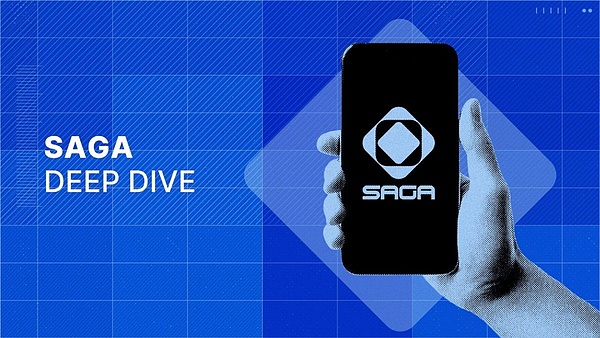
By providing an integrated automated, high-performance, no-gas-fee, interoperable and customizable chain stack Chainlets, the Saga protocol aims to provide developers with automated, parallelized and interoperable private chains to meet the needs of their Web3 applications.
The project uses shared security, cutting-edge validator orchestration and automated deployment pipelines to standardize deployment on any type of blockchain virtual machine, making launching a private chain or Chainlet as simple as deploying a smart contract.
In addition, Saga has launched Realms technology, a technical manifestation of the Saga multiverse that allows different technology stacks and IPs to be deployed on the protocol and interact through parallel and interoperable dedicated chains.
As part of the release of the incentive testnet, Saga is conducting an event to encourage developers, end users, validators and their community members to participate in the launch task and demonstrate behaviors that contribute to the Saga ecosystem. Participants will have the opportunity to receive Saga token airdrops. Saga emphasizes the power of its community and expresses its commitment to supporting the growth of its members.
On October 30, 2023, Saga announced the launch of its highly anticipated incentive testnet Pegasus, marking the beginning of multiple milestones, including Saga token airdrops and 282 Saga innovation projects. The launch of Pegasus provides game creators with more freedom to unleash their creativity on Saga.
Saga also announced the launch of the mainnet and the initial airdrop, which is designed to pay tribute to the contributors of the Cosmos, Polygon, Avalanche and Celestia communities who have made a commitment to the future of AppChain. The Saga token will be launched with the Saga mainnet on April 9, 2024, with a maximum supply of 1 billion tokens and an initial circulating supply of 90 million tokens, or 9% of the total supply.
2. Core Mechanism
Saga's core mechanism is built on a Layer1 blockchain protocol that provides unlimited horizontal scalability, and achieves this by enabling projects to launch their own Layer1 blockchains (L1s).
Here are several key features and mechanisms of the Saga Protocol:
(1) AppChain Development Portal
The AppChain Development Portal is a core component of the Saga Protocol that provides a one-stop solution that enables developers to easily deploy and manage their own dedicated blockchains, which are called AppChains.
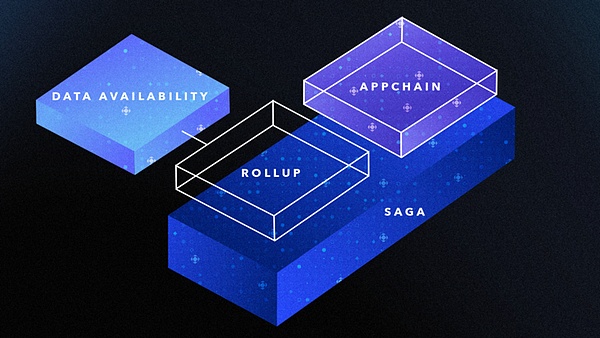
The concept of AppChain stems from the need for greater customizability and scalability in the blockchain field, especially when dealing with applications with specific functions or purposes.
Definition:An AppChain is a dedicated blockchain customized for a single application or service. Compared to traditional single blockchains, AppChains are able to provide more efficient performance, lower transaction fees, and are optimized for specific use cases.
Goal: Saga's AppChain Development Portal aims to simplify the blockchain development process, allowing developers to focus more on their applications themselves rather than the complexity of the underlying blockchain technology.
Key Features
User-friendly Interface: The Development Portal provides an intuitive, easy-to-use interface that enables developers to create and deploy AppChains in a few simple steps.
Chain Customization: The Development Portal allows developers to customize AppChain parameters such as consensus mechanism, block size, transaction fee model, etc. according to their specific needs.
Smart Contract Support: Similar to the deployment of smart contracts, developers can upload compiled smart contract binaries to the Saga mainnet, and Saga's validator will automatically process and deploy the corresponding Chainlet (a dedicated chain containing smart contracts).
Virtual Machine (VM) Agnostic: Supports multiple virtual machines, including but not limited to Ethereum Virtual Machine (EVM), Solana VM, etc., giving developers the flexibility to choose the technology stack that best suits their projects.
Operation Process
Design and Compile: Developers first design their applications and compile them into smart contract binaries.
Deployment: Upload the compiled smart contract binary to the Saga mainnet through the development portal.
Automated Processing:Saga’s validator automatically processes uploaded files and deploys a Chainlet containing the smart contract.
Management and Maintenance:The development portal provides tools and interfaces that enable developers to manage and maintain their AppChains, including upgrading smart contracts, adjusting chain parameters, etc.
Security and Efficiency
Shared Security Model:AppChains are secured through Saga’s shared validator pool, alleviating the need and cost of individually building and managing your own validator set.
Resource Isolation:Each AppChain runs in an independent environment, ensuring efficient resource utilization and optimized performance.
Application scenarios
Customized DApps: For decentralized applications (DApps) that require a high degree of customization and optimization, AppChain provides an ideal solution.
Enterprise-level applications: Enterprises and large organizations can use AppChain to create dedicated blockchain solutions for their specific business needs.
(2) Chainlets
In addition to AppChain, another unique feature of the Saga protocol is its stack building concept, called "Chainlets".
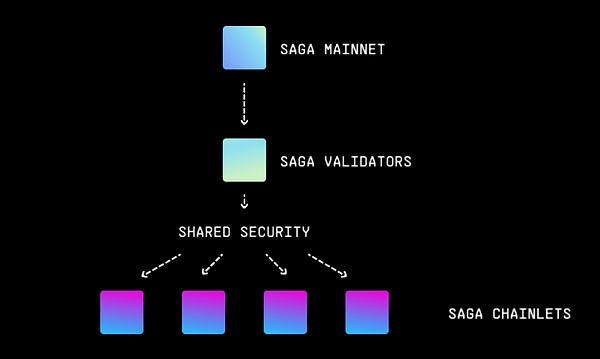
Chainlets is an innovative technology provided by Saga, designed to allow developers to easily deploy and manage their own dedicated blockchains to support specific applications or services. These Chainlets form the foundation of the Saga ecosystem, enabling it to provide unlimited horizontal scalability and a high degree of customization.
Definition
Chainlets can be viewed as micro-blockchains in the Saga network. Each Chainlet is an independent chain tailored to perform a specific function or service. They allow application developers to achieve a high degree of customization and optimization of their applications without sacrificing performance or security.
Main Features
Specialization and Customization: Chainlets provide dedicated block space for each application, allowing developers to customize the characteristics of the chain according to the specific needs of the application, such as consensus mechanism, transaction processing capacity and fee model.
Virtual Machine (VM) Agnosticism:Chainlets supports a variety of virtual machine technologies, including Ethereum Virtual Machine (EVM), Solana VM, etc., providing developers with flexibility in choosing a technology stack.
Shared Security Model: Chainlets rely on the shared validator pool of the Saga network to ensure security, which means that even newly created Chainlets can benefit from the overall security of the network.
Resource Isolation: Each Chainlet runs independently and does not share block space with other Chainlets, which reduces resource contention and improves performance and efficiency.
How Chainlets Work
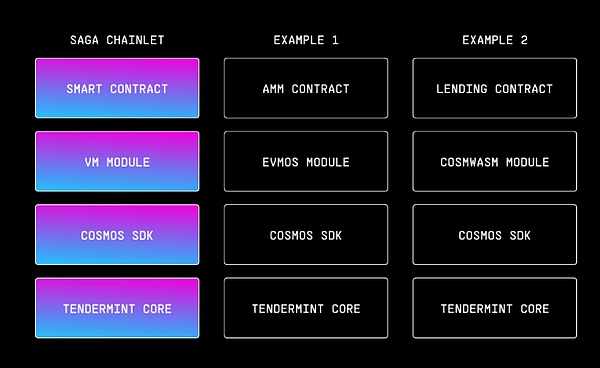
Design and Deployment: Developers first design their applications and corresponding smart contracts. They can then compile smart contracts into binary files and upload these files through Saga's AppChain development portal.
Automated Chainlet Deployment: The Saga network's validators automatically process uploaded smart contract binaries and deploy the corresponding Chainlets. This process is similar to deploying smart contracts on a traditional blockchain, but the result is the creation of a completely independent chain.
Operation and Management: Once a Chainlet is deployed, it begins to run independently, performing operations customized for a specific application. Developers can manage and maintain their Chainlets through Saga's tools and interfaces.
Application Scenarios
High-Performance DApps: Chainlets provide an ideal infrastructure for decentralized applications (DApps) that require high throughput and low latency.
Specialized Services: For services that require specialized security models or specific consensus mechanisms, Chainlets are able to provide customized solutions.
Games and Entertainment: Chainlets are particularly suitable for gaming and entertainment applications because they can provide the high-performance runtime environment and user experience required for these applications.
Through Chainlets, Saga provides developers with a powerful way to create and deploy blockchains tailored for their applications, which not only improves efficiency and performance, but also ensures high security and scalability. This innovative technology will make Saga an ideal choice for developers who are seeking to launch highly customized and optimized applications in the blockchain field.
(3) Realms
Saga's Realms technology is an advanced blockchain architecture concept designed to further improve the flexibility and scalability of blockchain technology. Through Realms, Saga is able to implement its unique layering and sharding mechanism, which is particularly critical for supporting large-scale, high-performance blockchain applications.
Definition
In the Saga protocol, "Realm" refers to a collection of dedicated blockchains or Chainlets that together serve a specific application, ecosystem, or set of functions. Realms technology allows these dedicated chains (or Chainlets) to operate in a highly customized and optimized manner, while also being able to interact and collaborate with each other when necessary.
Achieving Multiverse
Through its Realms technology, Saga has implemented the so-called "multiverse" concept, which supports different technology stacks and IP (smart property) to be deployed on the same protocol and interact through dedicated chains. This means that different development teams can create their own dedicated blockchains (Realms) within the Saga network, which can either operate independently or exchange data and assets with other Realms.
Features and Benefits
High Customizability: Realms allow developers to customize various parameters and functions of the blockchain according to the specific needs of their applications, including but not limited to consensus mechanisms, transaction processing rules, and the execution environment of smart contracts.
Interoperability: Although each Realm can run independently, Saga's architecture also supports interoperability between Realms, allowing communication and asset transfer between different blockchain applications and services.
Scalability: By distributing applications and services into dedicated Realms, Saga is able to achieve true horizontal scalability, and the expansion of each Realm will not affect other parts of the network.
Simplified deployment: Saga's architecture makes deploying a new Realm as simple as deploying a smart contract, greatly reducing the complexity of blockchain development and management.
Technical implementation
Saga's Realms technology is built on its core Layer1 protocol and supported by a series of highly optimized on-chain and off-chain mechanisms. This includes the use of efficient consensus algorithms, flexible data storage solutions, and advanced cross-chain communication protocols.
Application scenarios
Games and entertainment: For applications that require an independent operating environment and high user interactivity, such as massively multiplayer online games (MMOs), Realms technology provides an ideal solution.
Decentralized Finance (DeFi): DeFi platforms and services can use Realms to create dedicated transaction processing and clearing environments, improving efficiency and user experience.
Cross-chain services: For applications that need to interact with other blockchain ecosystems, Realms technology supports secure and efficient cross-chain transfer of assets and data.
Through Realms technology, Saga advances the boundaries of blockchain technology not only in theory but also in practice, providing developers with unprecedented flexibility and scalability, enabling them to build next-generation blockchain solutions for a variety of industries and application scenarios.
3. SAGA Token
SAGA token is the native cryptocurrency of Saga protocol and plays a key role in incentives and governance in Saga ecosystem. It is designed to support the operation of Saga network and encourage developers, validators and users to participate in and contribute to the development of ecosystem.
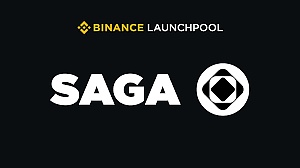
In early March this year, Saga announced the launch of Saga mainnet and the Genesis airdrop. The airdrop aims to pay tribute to Cosmos, Polygon, Avalanche and Celestia communities by awarding them tokens by rewarding their respective stakers. This is due to the commitment of the various projects to the future of AppChains, namely: Cosmos for the original AppChain concept, Celestia for Data Availability, Polygon for the Polygon Chain Development Kit (CDK), and Avalanche for the innovation of Avalanche Subnets.
In addition to this, tokens were awarded to the winners of Play-to-Airdrop Season 2, which was held in January-February 2024, and the Developer Tournament held in the same period.
The SAGA token went live on April 9th along with the Saga mainnet. The token has a maximum supply of 1 billion, with an initial circulation of 90 million, which is 9% of the total supply. The majority of these tokens were allocated to the ecosystem and developers, investors, and core contributors, who will be allocated 30%, 20%, and 20% of the token supply, respectively.
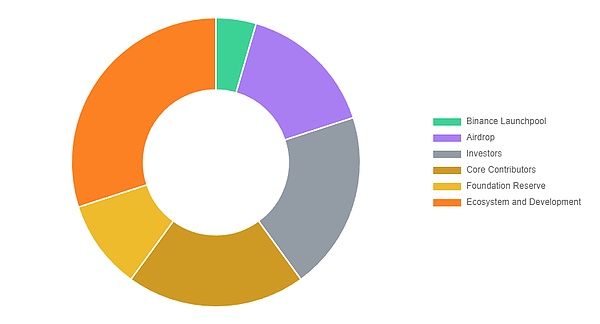
For investors and core contributors, their allocations are subject to a 1-year cliff and unlock over the next 2 years. For the remaining allocations, tokens will continue to vest over time, with the supply fully unlocked 7 years after the Token Generation Event (TGE).
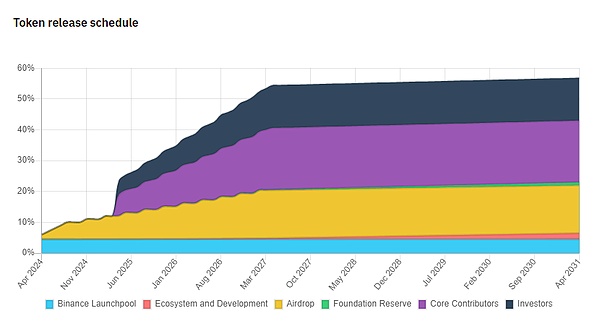
Binance announced the launch of the SAGA token launch pool on April 4 as the 51st launch pool project. Users who stake BNB or FDUSD in separate pools for four days can use these pools to mine SAGA tokens until April 9. Depositors will receive their respective token allocations from a pool of 45 million SAGA tokens, representing 4.5% of the total token supply. SAGA tokens were listed for trading on Binance on April 9.
4. Team/Funding
Saga’s team has deep industry experience, including members from the early days of the Cosmos (Tendermint) project. The team brings together heavyweights in research, engineering, and politics to provide leadership and direction for the project. They are building a strong web3 community, bringing together leading web3 projects, developers, and creators into the Saga multiverse through strategic partnerships.
To date, Saga has raised $15 million. Investors include Placeholder, Maven11, Longhash, Samsung, Com2uS, Polygon, Merit Circle, Figment and Chorus One. There are three known funding rounds:
Seed Round: Saga closed a $6.5 million seed round to build the next 1,000 blockchains. This round follows a $2 million pre-seed round from Ignite Inc. (formerly Tendermint) in late 2021, bringing Saga’s total funding to $8.5 million.
Seed Extension: Saga announced a $5 million seed extension round led by venture capital firm Placeholder. The investment brings Saga’s total funding to $13.5 million. Binance Launchpool: Saga debuted as the 51st project on Binance Launchpool, inviting users to deposit their BNB and FDUSD tokens into separate pools to mine SAGA tokens within four days.
5. Future Development Analysis
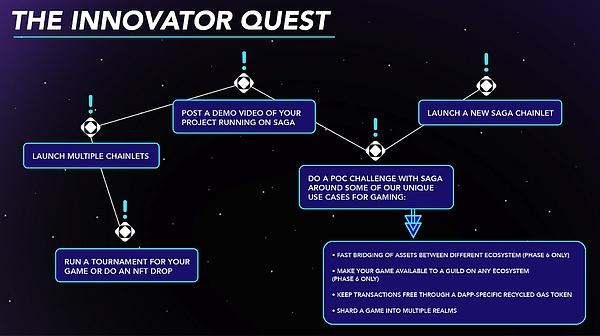
Combining the background of the Saga team, the financing situation and the unique nature of its blockchain protocol, we can analyze its future development potential from the following aspects:
Saga's technical framework - including support for AppChains and Chainlets, Realms technology, and its support for virtual machine agnosticism - puts it at the forefront of highly customized and scalable blockchain solutions. Especially in the field of games and entertainment, this technology can support the needs of high performance and user interactive experience. In addition, the high throughput and low latency environment provided by Saga will be very attractive for DeFi and other decentralized applications.
The team and supporters behind Saga have experts with experience in cryptographic and blockchain research, engineering, and related fields. The industry knowledge and technical expertise of the team members, coupled with their connections and influence in the blockchain ecosystem, will help drive the adoption and development of Saga.
Saga has successfully completed multiple rounds of financing, including from the well-known venture capital firm Placeholder, with a total financing amount of US$13.5 million, which provides it with financial security to promote early development and expansion. This shows that investors have confidence in Saga's business model and growth potential, which itself is an important driving force for the market to accept new technologies.
The Saga Protocol focuses on providing solutions for high-performance blockchain applications such as games and entertainment, which is a rapidly growing market sector. The blockchain game and related NFT (non-fungible token) markets are expanding, and Saga is likely to gain a leading position in this field with its ability to provide customized blockchains.
Saga has demonstrated its commitment to actively building communities and ecosystems through its Innovator Program and other community engagement activities. With the upcoming launch of its mainnet, which is expected to host more than 300 innovator projects, Saga has made substantial progress in expanding its ecological influence.
Of course, Saga's future development will also face a series of opportunities and challenges, which will jointly determine the long-term success or failure of this platform.
Opportunities
Market Growth: The growth of blockchain gaming and decentralized finance (DeFi) sectors provides a huge market opportunity. As these markets expand and demand increases, Saga's AppChain and Chainlet solutions have the potential to be more widely adopted.
Technical Advantages: The customized and scalable blockchain services provided by Saga, especially its Realms and Chainlets technologies, provide it with a technological advantage in the competitive Layer1 solution market.
Community Building: Saga has accumulated an active community in its ecosystem, which will help promote user growth and application development, which are key factors in ensuring the success of the platform.
Strategic Partners: Cooperation with industry big players such as Binance has increased Saga's exposure and may bring it more user and investor attention.
Challenges
Competitive Pressure: Competition in the blockchain space is fierce, with many established and emerging Layer1 protocols vying for market share. Saga needs to continue to innovate and provide unique value beyond its competitors to maintain its market position.
Technical Implementation: Saga's technical concepts, although innovative, may face many challenges in their actual implementation, including maintaining the security, scalability and user experience of the network.
User Adoption: Despite its technical advantages, end-user and developer adoption is uncertain. Saga needs to build a convincing case to attract developers to build on its platform and motivate users to use these applications.
Regulatory Environment: Cryptocurrency and blockchain technology face an ever-changing regulatory environment. Regulatory uncertainty may have a negative impact on Saga's development, especially in different regions around the world.
Market Volatility: Volatility in the cryptocurrency market may affect the stability of Saga's tokens and the project's ability to raise funds. Market sentiment has a significant impact on investment and capital flows.
Overall, Saga's success will depend on its ability to seize market growth opportunities, overcome technical and market challenges, and stay ahead in the evolving blockchain space. By maintaining its technological advantage, expanding its user base, and adapting to regulatory changes, Saga has the potential to become a major player in the blockchain space. However, all of this requires the Saga team to remain agile and effectively execute in strategic planning, product development, and marketing.
 JinseFinance
JinseFinance
 JinseFinance
JinseFinance JinseFinance
JinseFinance JinseFinance
JinseFinance JinseFinance
JinseFinance JinseFinance
JinseFinance JinseFinance
JinseFinance JinseFinance
JinseFinance Xu Lin
Xu Lin JinseFinance
JinseFinance JinseFinance
JinseFinance